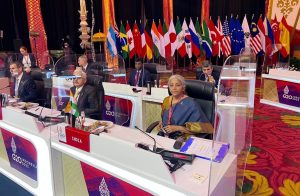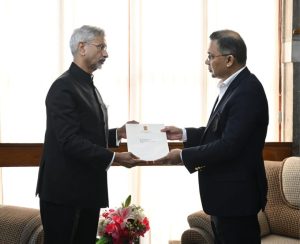G-20’s unfinished task in repairing economy from Covid-19
By Dr Gautam Naresh
New Delhi, August 27: India will be taking G20 Presidency soon at a time when the group still has an unfinished task on hand to take the global economy out of the impact of the Covid-19.
The Covid-19 pandemic is different, economically speaking, compared to the previous post-war pandemics that hit nations that were – at the time – far less economically dominant. This time, the hardest-hit nations include the G7 plus China.
This pandemic is different in another way. Manufacturing Sector gets a ‘Triple Hit’ Supply-chain contagion will amplify the direct supply shocks as manufacturing sectors in less-affected nations find it harder and/or more expensive to acquire the necessary imported industrial inputs from the hard-hit nations, and subsequently from each other.
There will be demand disruptions due to (1) macroeconomic drops in aggregate demand (i.e., recessions); and (2) wait-and-see purchase delays by consumers and investment delays by firms.
The likely nature of the economic shocks may include medical shocks such as workers in their sickbeds not producing GDP. Second is the economic impact of public and private containment measures – things like school and factory closures, travel restrictions, and quarantines.
The third is literally ‘all in our heads’.
Supply-side Shocks
The supply-side shocks are more tangible. The direct supply-side impact of human reactions to the virus are obvious and abundant. Authorities and firms in several nations shuttered workplaces and schools.
Japan presents clear and early examples. From an economic perspective, these closures and travel bans reduce productivity directly in a way that is akin to temporary drops in employment.
The size of the resulting output contraction may be attenuated today thanks to digital technology and cloud-based collaborative software and databases.
Supply-chain Shocks
China really is the workshop of the world, being central to the entire global network. So, manufacturing disruption there will create secondary supply shocks in manufacturing sectors in almost all nations.
There is a strong regional dimension in supply chains, so the fact that China, Korea, and Japan are among the five hardest hit means the supply-chain shock will be especially strongly felt in Asia.
Also noteworthy is the fact that India is not very involved in supply chains and so may be shielded somewhat from this form of economic contagion.

Demand-side Shocks
In past crises – like the Great Trade Collapse of 2008-09 – people and firms postponed purchases and delayed investments. This effect can be particularly pernicious since international media and personal communications can unintentionally synchronize such beliefs.
Put differently, the wait-and-see shock is contagious via the internet.
The demand-side shock need not travel along the traditional trade and financial bilateral connections.
Each of these first-round demand shocks are likely to be subject to four Keynesian multiplier like amplification.
For many people and companies around the world, not working means not getting paid – and that puts an additional damper on their demand.
Channels of COVID-19’s Economic Contagion
Globally, economies are connected by cross-border flows of: Goods; services; knowhow; people; financial capital; foreign direct investment; international banking; and exchange rates.
Economies are also connected – but not physically – by beliefs.
All these things are also mechanism for the propagation of economic shocks, or economic contagion.
Some of these flows within nations are also likely vectors connecting the medical and economic aspects of COVID-19.
Consider them in turn, starting with banks – which provide a convenient rallying point for contagion involving financial capital, beliefs, and international banking.
This would be in the areas of (1) Banks and other financial institutions, (2) Non-bank financial sector, (3) Trade, (4) Commodity trade and prices, (5) Travel and migration restrictions, (6) Deglobalization policy reactions, (7) Exchange rates, and (8) Capital flows.
The last classic mechanism of shock transmission is the sudden stop of capital flows.
During last decade’s Euro area crisis, for instance, the abrupt lending halt within the Euro area, is what put nations like Ireland and Portugal in a bind.
As with the exchange rate mechanism, this one does not seem to be in play during this crisis – or at least not yet.

Policy Reactions
The behaviour of the virus is one thing; governmental reaction is another.
The size and persistence of the economic damage will depend on how governments handle this sudden close encounter with nature and with fear.
On the dark side, it could become an economic crisis of global dimensions and a long-lasting reversal of globalization.
On the bright side, it could be the moment when policymakers manage a common crisis response.
They might even manage to rebuild some trust and create a cooperative spirit that helps humanity tackle other common threats like climate change. Government reactions to COVID-19 will be something like a Rorschach blot test.
Except this time, governments’ reactions will reveal the nature of their leaders and, more widely, that of societies. They can fail miserably by trying to hide the truth and being seen as acting opportunistically, or they can rise to the challenge and actually rebuild some trust.
Once the disease has disappeared from the headlines, people will see what is deeply wrong, or reassuringly good, about the systems in their country.
Many things go unnoticed because they have been part of the landscape for so long – for example, the dysfunctional aspects of the US healthcare system.
If many lives are lost, the failings will be exposed for all to see. The deeper question of the extent to which policy reactions to COVID-19 are driven by political factors, and which are driven by lower-frequency things like history, culture, ethnic divisions, political regimes, and election laws on one hand, and the price that societies attribute to the value of life on the other.
What Can Government Do to Reduce the Economic Pain?
In the adverse scenarios, there will be a need for a strong policy response at the macro level to contain the damage. The following array of the many possible economic policy responses may be.
Both monetary policy and fiscal policy action will be called for, and clearly the most effective action would be an internationally coordinated one.
Common approaches and announcements from the major central banks would be preferable to emergency actions from single ones.
Fiscal measures could quickly be deployed as targeted help for people affected by quarantines and income shortfalls.
In a catastrophic vision, more drastic action would be called for. A financial crisis plan to “flood the country with money in the right spots as insurance would” with judiciously targeted bailouts as the only way to keep businesses and people from going bankrupt.

While in 2008, world leaders came together to announce a common response to a common crisis. It was not perfect, but arguably it included coordinated fiscal stimulus and financial packages. And it is clear that the image of the G-20 cooperating in the face of a clear and present danger to the world economy contributed greatly to dampening the fear-shock that had rocked the world economy.
Today’s leaders are facing a similar stress test and they will be measured by their ability to deal with this common threat in an effective fashion.
Economic Survey2020-21 stated that since its first outbreak in Wuhan, China, COVID-19 infected all continents, including Antarctica (in December, 2020), and more than 220 countries.
In the initial stages of the pandemic, the Advanced Economies (AE) of North American and West European region were disproportionately impacted with more than 70 per cent of the total cases and total deaths.
The pandemic quickly intensified in number of Emerging Market and Developing Economies (EMDEs) such as Brazil, India, Mexico, Russia and Turkey.
(Author is Honorary Professor of Economics with the Foundation of Public Economics and Policy Research (FPEPR), Delhi, while he had previously been with National Institute of Public Finance and Policy (NIPFP), New Delhi)




